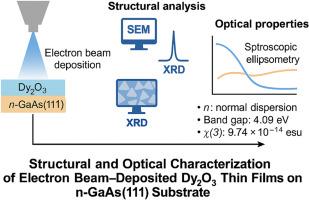Structural and optical characterization of electron Beam–Deposited Dy2O3 thin films on n-GaAs(111) substrate for photonic applications
IF 2.9
3区 物理与天体物理
Q3 NANOSCIENCE & NANOTECHNOLOGY
Physica E-low-dimensional Systems & Nanostructures
Pub Date : 2025-08-09
DOI:10.1016/j.physe.2025.116350
引用次数: 0
Abstract
In this study, dysprosium oxide thin films with a thickness of 15 nm were deposited onto an n-type gallium arsenide (111) substrate using electron beam evaporation under ultra-high vacuum conditions. The deposition process, carried out at 250 °C and followed by thermal annealing at 400 °C, yielded uniformly smooth films with good structural quality and interfacial integrity. Structural analysis through scanning electron microscopy and X-ray diffraction revealed uniform triangular surface features and confirmed the cubic phase of dysprosium oxide, with crystallographic alignment to the gallium arsenide substrate. Fourier-transform infrared spectroscopy validated the formation of dysprosium–oxygen bonds. The optical properties were extracted using spectroscopic ellipsometry. The refractive index exhibited normal dispersion, and the optical band gap was determined to be 4.09 ± 0.03 eV. Wemple–DiDomenico modeling provided the oscillator energy (5.02 ± 0.05 eV) and dispersion energy (9.80 ± 0.07 eV), while dielectric function analysis identified sharp electronic transitions attributed to intra-4f states of trivalent dysprosium ions. In the infrared region, classical dispersion relations enabled the extraction of key parameters, including the high-frequency dielectric constant (3.28 ± 0.05), plasma frequency (1.81 ± 0.04) × 1014 Hz, carrier relaxation time (2.26 ± 0.03) × 10−15 s, and carrier concentration to effective mass ratio ((3.69 ± 0.08) × 1047 g−1 cm−3). Energy loss analysis through surface and volume energy loss functions revealed distinct plasmonic and interband excitation features. Optical conductivity measurements highlighted excitonic and bulk plasmon activity in the 2.7–3.8 eV range. Nonlinear optical behavior was evaluated using Miller's rule, yielding a linear susceptibility of 0.155 ± 0.004 esu, a third-order susceptibility of (9.74 ± 0.21) × 10−14 esu, and a nonlinear refractive index of (2.40 ± 0.06) × 10−12 esu. Overall, the dysprosium oxide thin films demonstrated excellent crystallinity, high optical quality, and strong third-order nonlinear response, positioning them as promising candidates for advanced optoelectronic and photonic applications, including ultraviolet photodetectors, nonlinear optical modulators, and integrated optical devices.

光子应用中n-GaAs(111)衬底上电子束沉积Dy2O3薄膜的结构和光学特性
在超高真空条件下,利用电子束蒸发技术在n型砷化镓(111)衬底上沉积了厚度为15 nm的氧化镝薄膜。在250℃下进行沉积过程,然后在400℃下进行热退火,得到了均匀光滑的薄膜,具有良好的结构质量和界面完整性。通过扫描电子显微镜和x射线衍射的结构分析,发现了均匀的三角形表面特征,并证实了氧化镝的立方相,晶体学上与砷化镓衬底对齐。傅里叶变换红外光谱证实了镝氧键的形成。利用椭偏光谱法提取其光学性质。折射率呈正常色散,光学带隙为4.09±0.03 eV。Wemple-DiDomenico模型给出了振荡能量(5.02±0.05 eV)和色散能量(9.80±0.07 eV),而介电函数分析则确定了三价镝离子的4f内态的急剧电子跃迁。在红外区,利用经典色散关系可提取出高频介电常数(3.28±0.05)、等离子体频率(1.81±0.04)× 1014 Hz、载流子弛驰时间(2.26±0.03)× 10−15 s、载流子浓度与有效质量比((3.69±0.08)× 1047 g−1 cm−3)等关键参数。通过表面和体积能量损失函数进行的能量损失分析揭示了明显的等离子体和带间激发特征。光学电导率测量在2.7-3.8 eV范围内突出了激子和体等离子体活性。非线性光学行为采用米勒规则进行评估,得到线性磁化率为0.155±0.004 esu,三阶磁化率为(9.74±0.21)× 10−14 esu,非线性折射率为(2.40±0.06)× 10−12 esu。总的来说,氧化镝薄膜表现出优异的结晶度、高光学质量和强三阶非线性响应,使其成为先进光电和光子应用的有希望的候选者,包括紫外光电探测器、非线性光调制器和集成光学器件。
本文章由计算机程序翻译,如有差异,请以英文原文为准。
求助全文
约1分钟内获得全文
求助全文
来源期刊
CiteScore
7.30
自引率
6.10%
发文量
356
审稿时长
65 days
期刊介绍:
Physica E: Low-dimensional systems and nanostructures contains papers and invited review articles on the fundamental and applied aspects of physics in low-dimensional electron systems, in semiconductor heterostructures, oxide interfaces, quantum wells and superlattices, quantum wires and dots, novel quantum states of matter such as topological insulators, and Weyl semimetals.
Both theoretical and experimental contributions are invited. Topics suitable for publication in this journal include spin related phenomena, optical and transport properties, many-body effects, integer and fractional quantum Hall effects, quantum spin Hall effect, single electron effects and devices, Majorana fermions, and other novel phenomena.
Keywords:
• topological insulators/superconductors, majorana fermions, Wyel semimetals;
• quantum and neuromorphic computing/quantum information physics and devices based on low dimensional systems;
• layered superconductivity, low dimensional systems with superconducting proximity effect;
• 2D materials such as transition metal dichalcogenides;
• oxide heterostructures including ZnO, SrTiO3 etc;
• carbon nanostructures (graphene, carbon nanotubes, diamond NV center, etc.)
• quantum wells and superlattices;
• quantum Hall effect, quantum spin Hall effect, quantum anomalous Hall effect;
• optical- and phonons-related phenomena;
• magnetic-semiconductor structures;
• charge/spin-, magnon-, skyrmion-, Cooper pair- and majorana fermion- transport and tunneling;
• ultra-fast nonlinear optical phenomena;
• novel devices and applications (such as high performance sensor, solar cell, etc);
• novel growth and fabrication techniques for nanostructures

 求助内容:
求助内容: 应助结果提醒方式:
应助结果提醒方式:


